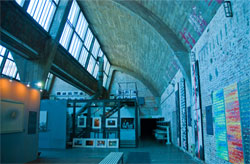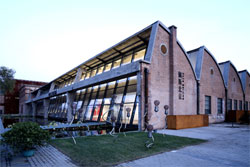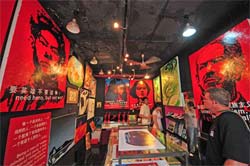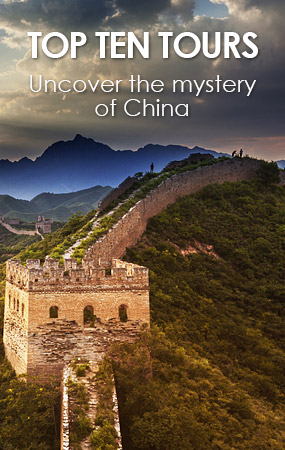798 Art District
 Set in a neglected and converted factory and built by the East Germans, 798 Art District is the city's leading focal point for contemporary art galleries. The industrial factory building, celebrates its working class roots from the communist era of the 1950s with red Maoist slogans remaining on the interior walls, at the artists request amongst pictures and statues of factory workers. The massive factory workshops are perfect for art galleries that require space for projects, such as multimedia installations.
Set in a neglected and converted factory and built by the East Germans, 798 Art District is the city's leading focal point for contemporary art galleries. The industrial factory building, celebrates its working class roots from the communist era of the 1950s with red Maoist slogans remaining on the interior walls, at the artists request amongst pictures and statues of factory workers. The massive factory workshops are perfect for art galleries that require space for projects, such as multimedia installations.
The feel of the place is exciting. The mix of modern art and the industrial environment in an old factory with pipes and chimneys complements this. It is on a large scale and you could easily spend a day visiting the complex exhibitions, events and its cafes and restaurants. It’s not straightforward to get to, but you’ll soon get over that and focus on the delights within and having a great day out. Some exhibitions change regularly and many remain permanently. Some galleries are more innovative than others. There is challenging and interesting work and work from artists that you won’t have heard of before.
History & Development
The factory was abandoned at the time when Beijing’s contemporary artists were looking for a new venue. Modern art wasn’t appreciated by the Government and most of the artists were working on back streets.
In 1995, the central Academy of Fine Arts (CAFA) set up in Factory 706. The move which was made on a temporary basis became permanent, and in 2000 the dean of the Department of Sculpture located to the district. The sculpture workshops remain open and working for visitors to watch the workers.
 Fashion designer Xiao Li and her performance artist husband helped artists obtain rental space in the area.
Fashion designer Xiao Li and her performance artist husband helped artists obtain rental space in the area.
Word spread, and more and more artists and designers arrived, attracted to the large available spaces and the industrial hub of the district became fashionable.
Beijing Tokyo Art Projects (BTAP) set up in the area, inside a 400 sq meter part of the renovated factory. The opening exhibition “Beijing Afloat” attracted over 1,000 revelers and the 789 district was born.
Next to BTAP is the 798 Space Gallery set up by the designer Huang Rui and photographer Xu Yong in 2002. It is where most visitors to the complex want to browse and is classed as the symbolic centre of the district. They are responsible for designing many other spaces in the area and became spokespersons for the area.
The District
 The district has become highly sought after and fashionable, since the opening of the complex. Galleries, design companies, cafes, restaurants and tailors have moved into the area. The businesses are on power with that of any fashionable district in any other major city around the world. A walk around the district and you’ll spot well dressed Beijingers and expensive cars on every corner, which main explain why there is a substantial waiting list of businesses wanting to get into the area.
The district has become highly sought after and fashionable, since the opening of the complex. Galleries, design companies, cafes, restaurants and tailors have moved into the area. The businesses are on power with that of any fashionable district in any other major city around the world. A walk around the district and you’ll spot well dressed Beijingers and expensive cars on every corner, which main explain why there is a substantial waiting list of businesses wanting to get into the area.
Fashionable night spots have established themselves in the district. Yan Club Arts Centre has a team that travels across China in search of new talent. The clubs criteria is concerned with quality and the genuine message communicated. The clubs esteem reputation means that it has close working relationships with some major artists that are on the Beijing scene. Artists promoted include; Rao Songqing whose landscapes sell at auction houses, Liu Baomin known for his trickery with imagery and Shen Dapeng’s oil and canvas. The club prides itself on showing their and others work in China and around the world and gain international recognition.
The back of the 798 Art District opens into an alley with various restaurants and other cafes for you to try, including Huang’s own café. It’s where artists eat and drink a kind of work canteen. You may find yourself rubbing shoulders with some of Beijing’s trendy artists and exhibitors.
Community Spirit
 Most of the galleries and spaces in the Dashanzi district do not charge exhibitors and visitors. They support themselves by hosting events, shows and corporate events with some high profile customers including Coca Cola, Microsoft, Nokia, Lancome and many others.
Most of the galleries and spaces in the Dashanzi district do not charge exhibitors and visitors. They support themselves by hosting events, shows and corporate events with some high profile customers including Coca Cola, Microsoft, Nokia, Lancome and many others.
Travel Information
Address: Ceramic 3 St, 798 Road, 798 Art Disttrict, 4 Jiuxianqiao Road, Chaoyang District
Transport: Take subway to Dongzhimen and then take bus 401

